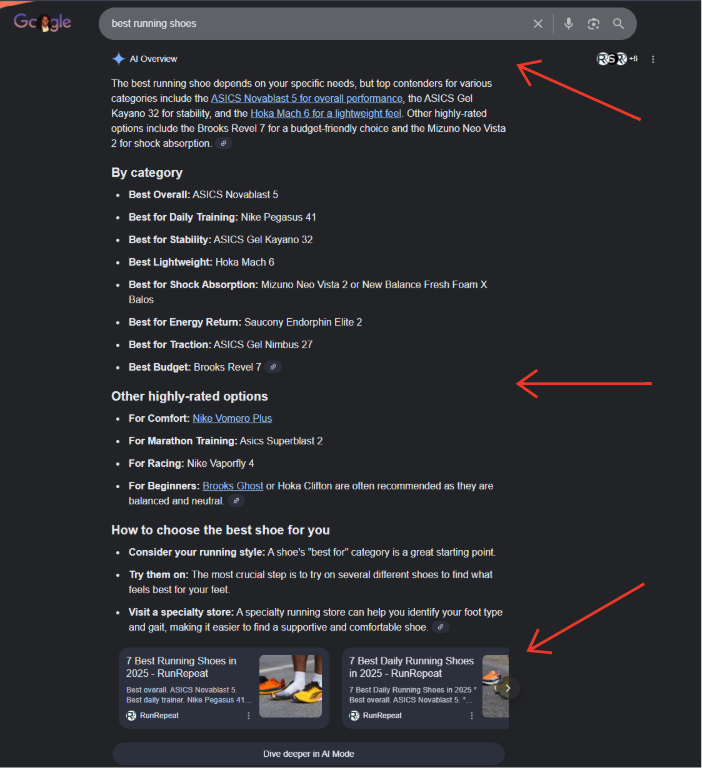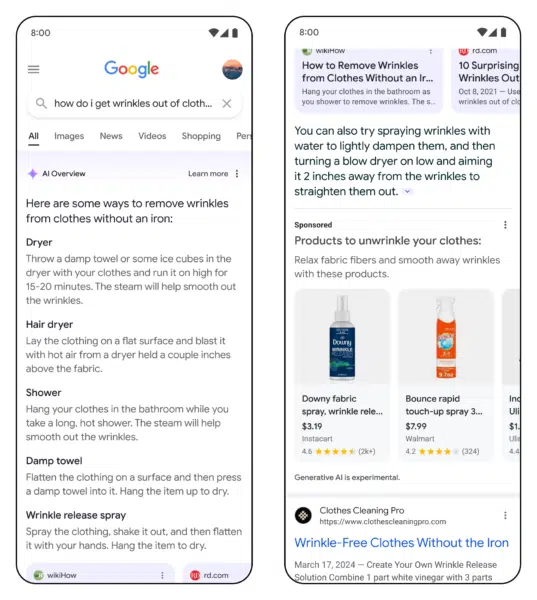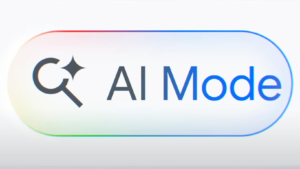Here’s the thing about search advertising – just when you think you’ve got it all figured out, Google throws you a curveball. And this time? It’s a big one.
AI Overview Ads have officially launched in Australia and New Zealand, and if you’re running search campaigns in this region, you need to pay attention.
Google’s been rolling this out with some serious urgency, and there’s a good reason for that: we’re looking at what could be the most significant shift in search advertising since, well, search advertising itself.
So What Exactly Are AI Overview Ads?
You’ve probably seen AI Overviews in your Google search results already – those AI-generated summaries that pop up when Google thinks a generative AI summary can be especially helpful.
They’re designed to help users quickly understand information from multiple sources without clicking through a dozen different websites.
Now, Google’s letting advertisers show up within, above, or below these AI-generated responses.
According to Google’s official documentation, these ads can appear in three distinct placements, and each one represents a different opportunity to connect with potential customers who are actively exploring and learning.
Think about it this way: someone searches “why is my pool green and how do I clean it” – that’s not a buying query, not yet anyway. But Google’s AI generates an overview about testing pool water, removing debris, vacuuming. Suddenly, there’s context. And within that context, ads for pool vacuum cleaners make perfect sense. That’s the magic here – ads that feel less like interruptions and more like helpful next steps.
Why the Rush?
The message coming through our partner channels has been clear: adopt Broad Match or AI Max now, because AI Overview Ads are here and they’re scaling fast.
Here’s what’s happening on the ground: ads in AI Overviews started rolling out at a small percentage of traffic across New Zealand and Australia on all devices.
But here’s the kicker – that’s expected to ramp up to 100% of eligible traffic in around 4-6 weeks.
Even at full rollout, ads will only trigger on queries that are deemed highly relevant and worthy of having ads.
The query coverage will increase over time as the system learns and iterates.
So we’re talking about an evolving landscape here, not a static one.
The advertisers who adapt early? They’re going to have a significant advantage as Google’s systems learn what works.
The Targeting Game Has Changed (Whether You’re Ready or Not)
Let me be straight with you – if you’re still running exact match keywords and calling it a day, you’re going to miss out. Big time.
AI Overview Ads trigger on what Google calls “no one right answer” queries. These are complex, exploratory searches where people are trying to understand something from multiple angles.
And here’s the thing: you’re probably not targeting those keywords. Nobody is, really, because they’re too broad, too varied, too… human.
That’s where AI-powered targeting comes in. Google’s pushing hard on broad match, Performance Max, AI Max for Search, and Dynamic Search Ads.
Why? Because traditional keyword targeting just can’t keep up with the variety and complexity of queries that trigger AI Overviews.
The system matches ads based on two factors: the user’s query and the content of the AI Overview itself. It’s like having a conversation where context matters just as much as what’s actually being said.
You can’t predict every possible query variation, but broad match combined with Smart Bidding? That can adapt in real-time.
What This Means for Your Campaigns (The Practical Stuff)
Alright, enough theory. What do you actually need to do?
1. Be aware your existing campaigns are already eligible.
If you’re running Search, Shopping, or Performance Max campaigns, your text and shopping ads can already show in and around AI Overviews. You don’t need to create something new from scratch, which honestly is a relief.
But to actually show up within the AI Overview content itself (not just above or below it), you need those AI-powered targeting solutions we talked about. Broad match on Search, or the keywordless targeting available through Performance Max and Dynamic Search Ads.
2. Understand your creative and product feeds matter more than ever.
When your ad is appearing alongside AI-generated content that’s genuinely trying to help someone, your ad needs to feel equally helpful. That means:
- Keep your product feeds updated constantly—Google’s AI is only as good as the data you give it
- Review your product descriptions, pricing, promotions regularly (and yes, I know that’s tedious, but it matters)
- Invest in quality images and videos for your products
- Make sure your landing pages actually deliver on what your ads promise
Google’s internal data shows that people have been finding ads within AI Overviews helpful because they can quickly connect with relevant businesses, products, and services at exactly the moment they need them.
That’s the standard you’re being held to – helpful, not just visible.
Industry Exclusions
Not everyone gets to play in this sandbox. Google’s maintaining restrictions on sensitive verticals, and it makes sense when you think about it. You won’t see ads in AI Overviews for finance, healthcare, pharma, adult content, alcohol, gambling, or politics.
This is due to regulatory requirements, the sensitive nature of these topics, and the need to be cautious about context. But here’s something interesting: ads can still appear above or below AI Overviews in these verticals, following the existing auction system. It’s only the ads within the AI Overview content that have these restrictions.
Reporting Limitations (For Now)
Also worth noting that there’s no segmented reporting yet for when your ads show within AI Overviews versus other placements.
Google’s acknowledged this and is actively considering feedback for future reporting options. For now, ads in AI Overviews are reported in aggregate in the Search terms report and as top ads.
What About AI Mode?
You might’ve heard about Ads in AI Mode – that’s different from what we’re talking about here, and honestly, it’s worth clarifying because the terminology can get confusing.
AI Mode is a more conversational search experience, and ads in that environment aren’t available in New Zealand yet. Google hasn’t announced a timeline either.
So when we’re talking about the urgent need to adapt? We’re specifically talking about AI Overview Ads, which are rolling out now across both desktop and mobile devices in Australia and New Zealand.
The Opportunity Hidden in Plain Sight
AI Overviews are showing up on queries that, historically, might not have had strong commercial intent. Someone researching how something works, comparing options in a general way, trying to understand a problem they’re having – these weren’t traditionally great conversion queries. They were top-of-funnel, awareness-stage stuff.
But Google’s AI is getting better at understanding the commercial intent within these exploratory queries. It’s reading between the lines. Someone asking about pool maintenance might not be actively shopping for a pool vacuum, but Google understands that they might need one soon. That’s a previously untapped moment of intent.
The advertisers who figure out how to show up in these moments – with genuinely helpful, contextually relevant ads – are going to reach potential customers earlier in their journey. Before they’ve decided on a solution. Before they’ve searched for your competitors. Before they’ve even fully articulated what they need.
That’s powerful. That’s the kind of shift that changes market share over time.
What XPON Is Seeing
As a leading Google Partner working with advertisers across Australia and New Zealand, we’ve been tracking this closely. And here’s what we’re telling our clients: this isn’t optional. This is the new normal, and it’s coming fast.
The timeline matters. Four to six weeks to ramp up to 100% of eligible traffic isn’t a lot of breathing room.
If you’re waiting to see how this plays out? By the time you have enough data to make a decision, your competitors will already be capturing those new moments of intent.
We’re encouraging advertisers to lean into broad match if they haven’t already – but not blindly. Broad match with Smart Bidding, backed by solid negative keyword lists and regular performance reviews.
It’s about giving Google’s AI room to find those valuable queries while still maintaining guard rails around what success looks like for your business.
Getting Started (Because Procrastination Won’t Help Here)
If you’re wondering where to begin, start simple. You don’t need to overhaul your entire account structure overnight.
Review your current match types. If you’re heavy on exact and phrase match, consider testing broad match on your best-performing keywords first. Use Smart Bidding—whether that’s Target CPA, Target ROAS, or Maximize Conversions with a target—to let Google’s AI optimise toward your actual business goals.
Look at your Performance Max campaigns. Make sure they’re properly set up with quality creative assets and clear conversion goals. These campaigns are automatically eligible for AI Overview Ads, so they’re your fastest path to showing up in these new placements.
And honestly? Don’t wait for perfect. Don’t wait until you’ve read every article, watched every webinar, and analysed every edge case. The system is learning as it goes, and so should you. Start testing, start gathering data, start learning what works for your specific business.
The Bottom Line (And Where We Go From Here)
AI Overview Ads represent a fundamental change in how search advertising works. They’re not just a new ad format or placement – they’re a shift in the types of queries where ads can appear and the way context influences ad relevance.
For Australian and New Zealand advertisers, the time to adapt is now. Not next quarter, not when you’ve finished your other priorities. Now. Because in 4-6 weeks, this will be the norm, and the question won’t be whether you’re using AI Overview Ads – it’ll be whether you’re using them effectively.
The search landscape is evolving. Google’s AI is getting better at understanding user intent, even when that intent is buried in exploratory, answer-seeking queries. Your ability to reach those users, in those moments, with genuinely helpful ads? That’s going to define search advertising success going forward.
So yeah, it’s a big change. But it’s also a massive opportunity.
And if you need help navigating this? That’s literally what we’re here for. At XPON, we’re working through this evolution alongside our clients, testing, learning, and adapting as Google rolls out these changes across the region.
Get in touch with our team if you need support.



